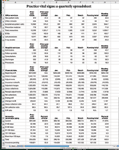Article
Checking your practice's vital signs
Here's how to analyze the numbers that reveal its financial health—or illness.
Heartbeat, pulse, temperature, respiration, and blood pressure can give you a quick assessment of a patient's health status. Likewise, there are basic measures you can use to monitor the financial health of your practice. You might call them your practice vital signs. They include data on patient volume, bread-and-butter services, revenue production, billings, and collections.

As you can see, just four tables are involved-office services, hospital services, financial data, and accounts-receivable aging. The format is roughly the same for each. Totals for the prior year of practice come first, serving as a benchmark. Next, we record tallies for each month, followed by a monthly average for the current year. Set up properly, your spreadsheet should be able to automatically calculate new averages, totals, ratios, and percentages each time you enter new monthly data.
With a report like this, you can track major procedures, assess your business manager's effectiveness, determine whether a special effort is needed to clear up aging accounts, evaluate the use of billing codes, and periodically answer the question, "How well is my practice doing?" The answer may help you add thousands of dollars to your bottom line. Even if you don't get that result, the report will help you understand where you are and where you're going.
Patient services
In primary care practices, the key things to monitor are new-patient visits, office consultations, established-patient visits, preventive-medicine visits, and patient encounters as a whole. Larger practices with multiple offices might track these by location.
Whatever your situation, it's important to segregate new-patient visits from office consultations. An office consultation is an encounter prompted by another doctor's request for your medical opinion. In contrast, a new-patient visit is essentially a self-referral. Since consults are generally paid at a higher rate than new-patient visits-often 25 percent higher-it pays, particularly for specialists and subspecialists, to have as many initial encounters as possible qualify as consultations.
For instance, we recently analyzed the practice of a solo cardiologist and found that he habitually coded every first encounter as a new-patient visit, when in truth probably two-thirds of them had been generated by physician referrals and qualified as consults. This meant he was giving up $25 to $35 per patient, or about $15,000 to $20,000 a year, depending on patient volume. A monthly report on your business vital signs can alert you to this type of mistake.
Another thing to take a close look at is the line for preventive services. That's where annual physical exams should be showing up. For years-because insurance policies covered only the treatment of illness-doctors tried to find diagnostic problems to put on claim forms to qualify these exams as acute visits.





